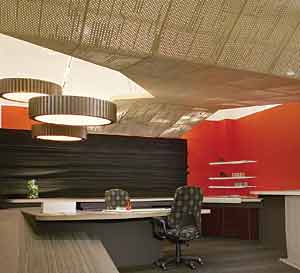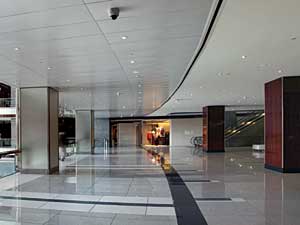Perforated Metal and Wood Ceilings: Sustainability, Acoustics, and Aesthetics
|
Form-Giving Potential
Rapid advances in computer-aided manufacturing (CAM) and product engineering have made it possible to fabricate customized perforated panels. Ceiling panels can now be fabricated to almost any size and shape, with design information from Building Information Models (BIM) or architectural drawings used to produce the automated fabrication instructions. This new design process allows architects to break away from the regimentation of traditional grids by using larger panels that better fit the scale of a room and by creating panels with radii and compound curvatures that can flow throughout a freeform space.
|
Automated punches can make as many as 7,000 perforations per minute. To satisfy the designer's vision, each hole can be in a unique size, shape, and location. This allows panels to be perforated with an unlimited variety of patterns and unique designs. For example, perforations can be slots, polygons, and oblongs, as well as more traditional circles and squares. Custom perforation patterns can create corporate logos or graphic motifs on the ceiling, and the density of holes can vary from one end of a panel to another to create the illusion of motion.
The same machinery that punches the perforations can also be used to create openings for the installation of lighting and other ceiling-mounted fixtures.
Perforation size, layout, and spacing can vary to create an open area as large as 50 percent or more of a panel. In addition to affecting appearance, this open area has practical implications such as whether fire sprinklers can be installed above a ceiling or whether panels can be backlit to create a luminous ceiling.











